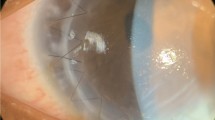Abstract
• Background: The isoxal derivative, leflunomide (LF), is a new potent immunosuppressive which has been shown to be effective in preventing autoimmune disorders and reactions leading to organ transplantation rejection. LF is thought to antagonise cytokine activity and thereby to interfere with T-helper-cell-dependent B- and T-lymphocyte proliferation. • Methods: We used LF to treat corneal allograft rejection in the rat, comparing its effect with that of cyclosporin A (CSA). Corneal buttons were grafted from Lewis/Brown Norway rats to Lewis recipients. Animals were randomly assigned to the following treatment groups: I, untreated; II, CSA (10 mg/kg i.m.); III, LF (2.5 mg/kg p.o.); IV, LF (5 mg/kg p.o.); V, LF (10 mg/kg p.o.); VI, combined therapy (LF 10 mg/kg p.o. and CSA 10 mg/kg i.m). Treatment began on the first postoperative day and was continued until rejection occurred. • Results: The mean graft rejection time in the untreated allogeneic group was 12 days. A significant delay in graft rejection was observed in all treatment groups compared with group I (P<0.001). Further, the delay in graft rejection resulting from combined therapy (group VI) was statistically significant compared with all other groups (P<0.001). • Conclusion: These results suggest that (a) LF when used alone is as effective as CSA in treating corneal allograft rejection in the rat, and (b) when LF and CSA are combined they are more effective than either drug alone in the prolongation of allograft survival.
Similar content being viewed by others
References
Bartlett RR (1986) Immunopharmacological profile of HWA 486, a novel isoxazol derivative. II. In vivo immunomodulating effects differ from those of cyclophosphamide, prednisolone or cyclosporin A. Int J Immunopharmacol 8:199–204
Bartlett RR, Dimitrijevic M, Mattar T, Germann T, Rüde E, Thoenes GH, Küchle CCA, Schlorlemmer HU, Bremer E, Finnegan A, Schelyerbach R (1991) Leflunomide (HWA 486), a novel immunomodulating compound for the treatment of autoimmune disorders and reactions leading to transplantation rejection. Agents Actions 32:10–21
Basu PK, Hasany SM (1971) Histochemical localization of hydrolytic enzymes during corneal graft reaction. Can J Ophthalmol 10:239–247
Basu PK, Taichman NS (1973) Hydrolytic enzymes in corneal graft rejection. Can J Ophthal 8:577–581
Belin MW, Bouchard CS, Phillips TM (1990) Update on topical cyclosporin A. Background, immunology and pharmacology. Cornea 9:184–195
Callanan DG, Luckenbach MW, Fischer BJ, Peeler JS, Niederkorn JY (1989) Histopathology of rejected orthotopic corneal grafts in the rat. Invest Ophthalmol Vis Sci 30:413–424
Chong ASF, Gebel H, Finnegan A, Petraitis EE, Jiang XL, Sankary HN, Foster P, Williams JW (1993) Leflunomide, a novel immunomodulatory agent: in vitro analyses of the mechanism of immunosuppression. Transplant Proc 25:747–749
Faulds D, Goa KL, Benfield P (1993) Cyclosporin. A review of its pharmacodynamic and pharmacokinetic properties, and therapeutic use in immunoregulatory disorders. Drugs 45:953–1040
Holland EJ, Chan CC, Wetzig RP, Palestine AG, Nussenblatt RB (1991) Clinical and immunohistologic studies of corneal rejection in the rat penetrating keratoplasty model. Cornea 10:374–380
Khodadoust AA (1968) Lamellar corneal transplantion in the rabbit. Am J Ophthalmol 66:1111–1117
Khodadoust AA (1973) The allograft rejection reaction: the leading cause of late failure of clinical corneal grafts. In: Porter R, Knight J (eds) Corneal graft failure. (Ciba Foundation Symposium) Elsevier, Amsterdam, pp 151–167
Khodadoust AA, Silverstein AM (1969) Transplantation and rejection of individual cell layers of the cornea. Invest Ophthalmol 8:180–195
Küchle CCA, Thoenes GH, Langer KH, Schlorlemmer HU, Bartlett R, Schleyerbach R (1991) Prevention of kidney and skin graft rejection in rats by leflunomide, a new immunomodulating agent. Transplant Proc 23:1083–1086
Maumenee AE (1951) The influence of donor-recipient sensitization on corneal grafts. Am J Ophthalmol 34:142–152
Niederkorn JY, Lang LS, Ross J, Mellon J, Robertson SM (1993) Promotion of corneal allograft survival with leflunomide (HWA 486), a novel immunomodulating agent. Invest Ophthalmol Vis Sci (in press)
Paque J, Poirier RH (1977) Corneal allograft reaction and its relationship to suture site neovascularization. Ophthalmic Surg 8:71–74
Pasternak RD, Wadopian NS, Wright RN, Siminoff P, Gylys JA, Buyniski JP (1987) Disease modifying activity of HWA 486 in rat adjuvant-induced arthritis. Agents Actions 21:241–243
Polack FM (1962) Histopathological and histochemical alterations in the early stages of corneal graft rejection. J Exp Med 116:709–717
Rozman B, Mladenovic V, Domlian Z, Jajic I,Popovic M, Mihailovic D, Zivkovic M, Musikic P, Campion G (1992) The effects of leflunomide (LF) in patients with rheumatoid arthritis (RA). Arthritis Rheum 35 [Suppl]: 108
Schorlemmer HU, Seiler FR, Bartlett RR (1993) Prolongation of allogeneic transplanted skin grafts and induction of tolerance by leflunomide, a new immunosuppressive isoxazol derivative. Transplant Proc 25:763–767
Smith Lang L, Glaser B, Weimer LK, Miller ST, Robertson SM, Aoki KR, Yanni JM (1992) Efficacy of novel immunomodulators leflunomide and rapamycin in autoimmune uveitis. FASEB J 6: A1048
Streilein JW, McCulleyJP, Niederkorn JY (1982) Heterotopic corneal grafting in mice: a new approach to the study of corneal alloimmunity. Invest Ophthalmol Vis Sci 23:489
Treseler PA, Sanfilippo F (1986) The expression of major histocompatibility complex and leucocyte antigens by cells in the rat cornea. Transplantation 41:248
Williams JW, Xiao F, Foster PF, Chong A, Sharma S, Bartlett RR, Sankary HN (1993) Immunosuppressive effects of leflunomide in a cardiac allograft model. Transplant Proc 25:745–746
Williams KA, Coster DJ (1985) Penetrating corneal transplantation in the inbred rat: a new model. Invest Ophthalmol Vis Sci 26:23–30
Author information
Authors and Affiliations
Additional information
Presented in abstract form at the Berlin-Brandenburg Eye Congress, 4–5 December 1993. None of the authors has any proprietary or financial interests in the compound leflunomide
Rights and permissions
About this article
Cite this article
Coupland, S.E., Klebe, S., Karow, AC. et al. Leflunomide therapy following penetrating keratoplasty in the rat. Graefe's Arch Clin Exp Ophthalmol 232, 622–627 (1994). https://doi.org/10.1007/BF00193123
Received:
Revised:
Accepted:
Issue Date:
DOI: https://doi.org/10.1007/BF00193123




